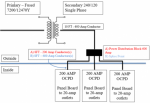cottora
Senior Member
- Location
- Atlanta, GA
First, a great forum! I have lurked around and learned so much.
I am working with an Electrical Engineer for a design that will essentially have multiple bays with each bay containing three 200-amp panel boards. The question is around what is a tap and if we can split vs taking each panel board back to the transformer (or back to another OCPD since the transformer will be very close to the "distribution block").
The idea is to go from the secondary side of a 240/120 transformer with 15ft of 600 amp conductor - into a Power Distribution Block (600 amp) - and then inside via three separate 8ft 200 amp conductors which terminate into a 200 amp Panel Board (with 200 amp OCPD). This will be done ten times (which is why we would like to split the feeder since the transformer will run out of room)
I do not think (but I am not sure) that the above is within NEC guidelines, but I believe it would be ok if we ran each 200 amp conductor back to the transformer.
Any thoughts/guidance would be greatly appreciated!
Raine
I am working with an Electrical Engineer for a design that will essentially have multiple bays with each bay containing three 200-amp panel boards. The question is around what is a tap and if we can split vs taking each panel board back to the transformer (or back to another OCPD since the transformer will be very close to the "distribution block").
The idea is to go from the secondary side of a 240/120 transformer with 15ft of 600 amp conductor - into a Power Distribution Block (600 amp) - and then inside via three separate 8ft 200 amp conductors which terminate into a 200 amp Panel Board (with 200 amp OCPD). This will be done ten times (which is why we would like to split the feeder since the transformer will run out of room)
I do not think (but I am not sure) that the above is within NEC guidelines, but I believe it would be ok if we ran each 200 amp conductor back to the transformer.
Any thoughts/guidance would be greatly appreciated!
Raine



